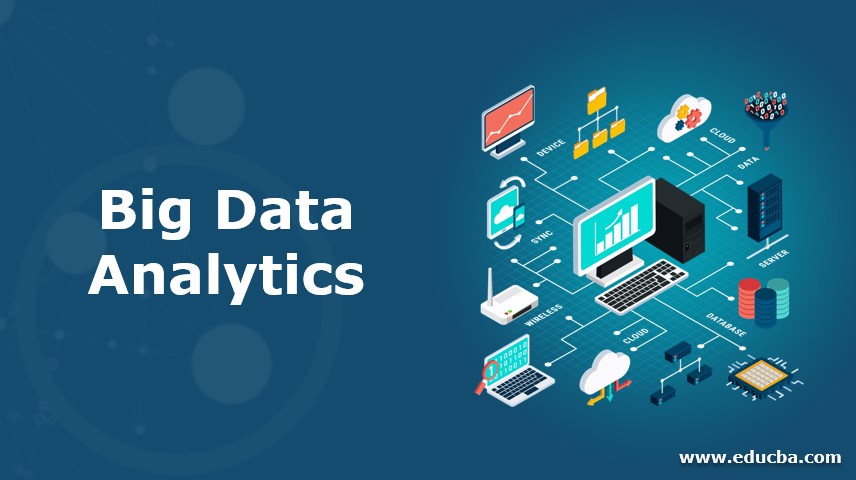Updated June 20, 2023
Introduction to Big Data Analytics
A field to analyze and extract information about the big data involved in the business or the data world so that proper conclusions can be made is called big data Analytics. These conclusions can be used to predict the future or to forecast the business. Also, this helps in creating a trend about the past. Skilled professionals in statistics and engineering with domain knowledge are needed to analyze big data as the data is huge, and analysis needs proper determination and skillset. Traditional analysis methods are insufficient to handle the complexity of this data.
We can Define Big Data as Three Vs
- Volume: The amount of data that is being generated every second. Every day organizations like social media, e-commerce businesses, and airlines collect a huge amount of data.
- Velocity: The rate at which the data is generated. Everybody is using Social Media, and there will be lots of data generated every second because people do many things over social media; they post comments, like photos, share videos, etc.
- Variety: Data can take various forms, including structured data such as numeric data, unstructured data such as text, images, videos, financial transactions, etc., or semi-structured data like JSON or XML.
What are we Doing with this Big Data?
We can use this big data to process and draw some meaningful insights out of it. There are various frameworks available to process big data. The list below provides the popular framework that big data developers and analysts use widely.
- Apache Hadoop: We can write map-reduce the program to process the data.
- Spark: We can write a Spark program to process the data; we can also process a live data stream using Spark.
- Apache Flink: This framework is also utilized for processing data streams.
And many more like Storm and Samza.
Big Data Analytics
Big Data analytics is collecting, organizing, and analyzing a large amount of data to uncover hidden patterns, correlations, and other meaningful insights. It helps an organization to understand the information in their data and use it to provide new opportunities to improve their business, leading to more efficient operations, higher profits, and happier customers.
To analyze such a large volume of data, Big Data analytics applications enable big data analysts, data scientists, predictive modelers, statisticians, and other analytical performers to analyze the growing importance of structured and unstructured data. Performing these tasks involves the utilization of specialized software tools and applications. Using these tools, one can perform various data operations such as data mining, text mining, predictive analysis, forecasting, etc. High-performance analytics relies on carrying out these processes individually as integral components. Using Big Data analytic tools and software enables an organization to process a large amount of data and provide meaningful insights that deliver better business decisions in the future.
Key Technologies Behind Big Data Analytics
Analytics comprises various technologies that help you get the most valued information from the data.
1. Hadoop
People widely use the open-source framework to store a large amount of data and run various applications on a cluster of commodity hardware. The constant increase in the variety and volume of data has positioned it as a key technology in big data, and its distributed computing model facilitates faster access to data.
2. Data Mining
Once the data is stored in the data management system, you can use data mining techniques to discover the patterns for further analysis and answer complex business questions. Data mining removes all the repetitive and noisy data and points out only the relevant information used to accelerate the pace of making informed decisions.
3. Text Mining
With text mining, we can analyze the text data from the web, like the comments, likes from social media, and other text-based sources like email; we can identify if the mail is spam. Text Mining uses technologies like machine learning or natural language processing to analyze large amounts of data and discover patterns.
4. Predictive Analytics
Predictive analytics uses data, statistical algorithms, and machine learning techniques to identify future outcomes based on historical data. It’s all about providing the best future outcomes so organizations can feel confident in their business decisions.
Benefits of Big Data Analytics
Big Data Analytics has been popular among various organizations. Organizations like the e-commerce, social media, healthcare, Banking, and Entertainment industries widely use analytics to understand multiple patterns, collect and utilize customer insights, fraud detection, monitor financial market activities, etc.
Let’s take an example of the e-commerce industry:
E-commerce industries like Amazon, Flipkart, Myntra, and many other online shopping sites use big data.
They collect customer data in several ways like
- Collect information about the items searched by the customer.
- Information regarding their preferences.
- Information about the popularity of the products and many other data.
Using these kinds of data, organizations derive some patterns and provide the best customer service, like
- We showcase the popular products being sold.
- Show the products that are related to the products that a customer bought.
- We ensure secure money transfers and actively detect any fraudulent transactions that occur.
- Forecast the demand for the products and many more.
Conclusion
Big Data is a game-changer. Many organizations use more analytics to drive strategic actions and offer a better customer experience. A slight change in efficiency or the smallest savings can lead to a huge profit, which is why most organizations are moving towards big data.
Recommend Articles
This has been a guide to Big Data Analytics. Here we have discussed basic concepts like what is Big data Analytics, its benefits, and the key technology behind Big data Analytics. You may also look at the following articles to learn more –




